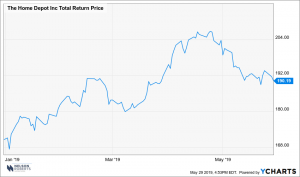Nelson Capital Management


 Home Depot (tkr: HD), with a market cap of $215 billion and 2018 revenues of over $100 billion, is the world’s largest home improvement retailer. Offerings include building materials, home improvement products, lawn and garden products and home décor items. Home Depot also provides a number of services, including home improvement installation services and tool and equipment rental. Its warehouse format stores stock over 35,000 products, while one million products are available online. The company’s nearly 2,300 stores are in the U.S. (almost 2,000), Canada (just under 200) and Mexico (about 125), for a total of 13% outside the U.S. The company employs over 400,000 people, 93% of whom earn hourly wages.
Home Depot (tkr: HD), with a market cap of $215 billion and 2018 revenues of over $100 billion, is the world’s largest home improvement retailer. Offerings include building materials, home improvement products, lawn and garden products and home décor items. Home Depot also provides a number of services, including home improvement installation services and tool and equipment rental. Its warehouse format stores stock over 35,000 products, while one million products are available online. The company’s nearly 2,300 stores are in the U.S. (almost 2,000), Canada (just under 200) and Mexico (about 125), for a total of 13% outside the U.S. The company employs over 400,000 people, 93% of whom earn hourly wages.
Home Depot has two customer segments: professional and do-it-yourself (DIY). The acquisition of Interline in 2015 allowed Home Depot to enter the MRO market (maintenance, repair and operations, delivering supplies and services needed to maintain and upgrade multifamily, hospitality, healthcare and institutional facilities). One additional and growing market is the “do-it-for-me” (DIFM) customer, typically a homeowner who purchases materials at Home Depot and then hires a “Pro” to complete the project or installation. Alongside the aging of the baby boomer generation, there has been a transition from “DIY” to “DIFM,” a trend which Home Depot is well-positioned to capitalize on.
 While Home Depot faces some risk from slowing in the housing market, the company has considerable opportunities to expand into adjacent businesses, take market share (for example, appliances from Sears) and drive its online presence. Stronger penetration of the Pro business, particularly MRO, is also an opportunity. Home Depot has knowledgeable, helpful employees and does a lot of “culture” training. Since the domestic home improvement market is relatively mature, management plans to focus on the growth opportunities listed above, as well as on driving margins, including improvements in speed and efficiency in the supply chain.
While Home Depot faces some risk from slowing in the housing market, the company has considerable opportunities to expand into adjacent businesses, take market share (for example, appliances from Sears) and drive its online presence. Stronger penetration of the Pro business, particularly MRO, is also an opportunity. Home Depot has knowledgeable, helpful employees and does a lot of “culture” training. Since the domestic home improvement market is relatively mature, management plans to focus on the growth opportunities listed above, as well as on driving margins, including improvements in speed and efficiency in the supply chain.
Lowe’s is Home Depot’s largest and most similar competitor. Although Amazon is always a threat, the specialized nature of many of Home Depot’s products, the need for expert purchasing advice in real-time, and the high weight-to-size ratio of many items offer significant protection from online competition. We bought Home Depot as part of our pivot toward more value-oriented stocks. Home Depot is an appropriate “pivot” holding because it is large, primarily U.S.-based, well-managed, pays a reliable dividend and offers products to the vast middle of the market, rather than focusing on luxury/upscale customers.
Individual investment positions detailed in this post should not be construed as a recommendation to purchase or sell the security. Past performance is not necessarily a guide to future performance. There are risks involved in investing, including possible loss of principal. This information is provided for informational purposes only and does not constitute a recommendation for any investment strategy, security or product described herein. Employees and/or owners of Nelson Roberts Investment Advisors, LLC may have a position securities mentioned in this post. Please contact us for a complete list of portfolio holdings. For additional information please contact us at 650-322-4000.
Receive our next post in your inbox.